The Cornell Lab Bird Academy › Discussion Groups › Nature Journaling and Field Sketching › Capturing Behavior – Gesture Drawing
-
 I enjoyed the different stances that the eagles made. How they used their shoulder muscles to pull apart prey.
I enjoyed the different stances that the eagles made. How they used their shoulder muscles to pull apart prey. -

-



-
Gesture drawing was easiest with still subjects! The foxes were amazing but I had to replay many times to get the drawings beyone one little jot! Here are also my bird feeder drawings, that was also hard - especially the birds, very very fast moving. More success with squirrels, also moving but repeat motions. The woodpecker was the most successful to try to draw. I think it's helping me with my observations as I am better able to predict what the next move will be, with the squirrels and the speedy birds. Also more observant of the markings, which I've been pretty lazy about in the past - like, what kind of woodpecker?



-
I’m not quite there with the video or bird feeder yet, but if they would just stay still for a minute I can do it.

-
I'm beginning to get the shape better. The questions you ask yourself and put on the page are fun! While watching the birds, there must be either a hawk or owl around because there is not one squirrel anywhere! I need to keep practicing - the foxes are fun but really really hard. I do that many times. I'm better at birds.

-
This gesture drawing makes me a bit more concern about what posture to draw. I think I need to practice more to get faster on paper, and to drop faster the subject when in move. Maybe doing more drawing without looking much at the result. In the vídeo of the foxes the rounded shapes of the puppy was a thing I noticed but couldn't put on paper. Also the shape of the ears in both animals was a point of focus but not well translated on paper. Last thing I notice was when the adult fox lay down the tail is the "same" size as the body (I know that's an illusion). I also add my drawings from the vídeo of the birds on the feeder. The titmouse was too fast for me. The woodpecker was good for drawing the doves allow me to get various sketchy intents.


-
This was really hard! I got bogged down early on in details of the adult’s face, but then I loosened up and quickly captured the kit’s nuzzling the adult’s face. I finally paused the video at the end so I could draw the pair hunkered down together.

-

 I found that with my attempts at gesture drawing I tend to try to do some refining of my sketches rather than continuing on to the next subject. I see the importance of getting the gestures down as accurately and as quickly as possible because the subjects move so quickly, such as the song birds and squirrels that frequent my yard. I've included 2 pages; the 1st page has to 2 parts, the top half shows gesture sketches from a window overlooking my bird feeders (that have been taken over by red squirrels) I've tried to capture a few gesture sketches of red squirrels, chickadees and woodpeckers, the bottom half of the page is from a walk in my woods this morning showing scenes from a tree trunk with moss and some kind of mushroom that dried out and puffs out powder when you flatten it, another scene is of geese flying overhead. The mushroom or toadstool, whatever it is, leads to a great question as to finding out just what it is and why it puffs out a brownish powder, questions that lead to other questions that need answering. The 2nd page is from the video with Liz at the bird feeders in Sapsucker Woods. The fox video was very hard to follow as the baby fox was so active. That one was really a challenge.
All in all I think gesture drawing is a great practice for every session or as a warm up. I think it is quite fun to do.
I found that with my attempts at gesture drawing I tend to try to do some refining of my sketches rather than continuing on to the next subject. I see the importance of getting the gestures down as accurately and as quickly as possible because the subjects move so quickly, such as the song birds and squirrels that frequent my yard. I've included 2 pages; the 1st page has to 2 parts, the top half shows gesture sketches from a window overlooking my bird feeders (that have been taken over by red squirrels) I've tried to capture a few gesture sketches of red squirrels, chickadees and woodpeckers, the bottom half of the page is from a walk in my woods this morning showing scenes from a tree trunk with moss and some kind of mushroom that dried out and puffs out powder when you flatten it, another scene is of geese flying overhead. The mushroom or toadstool, whatever it is, leads to a great question as to finding out just what it is and why it puffs out a brownish powder, questions that lead to other questions that need answering. The 2nd page is from the video with Liz at the bird feeders in Sapsucker Woods. The fox video was very hard to follow as the baby fox was so active. That one was really a challenge.
All in all I think gesture drawing is a great practice for every session or as a warm up. I think it is quite fun to do. -
While trying to gesture draw I find myself stopping frequently to refine my marks rather than going on to the next quick sketch. But I can see the importance of doing it often and trying to catch a movement on paper that I would otherwise miss. I think it's rather fun to do. I've included my sketches, the 1st is the video with Liz doing her gesture drawing while at the bird feeder in Sapsucker Woods, I watch the same feeder via Youtube, also on that page I've included the Fox video sketches which were very difficult as the little fox was so active. The second photo is from my window facing my bird feeders.


-
With gesture drawing, I noticed a lot of details that I would probably have perceived as stereotypical. For example the eyes of the adult fox were not round, but more of a line, a squinty kind of look most of the time. Also I noticed how bushy the adult's tail was in comparison to its molting coat. I wondered if the bushiness of the tail was because the fox could still use it to keep warm when curled up, if the weather turned cold, which I imagine it can in Alaska. I noticed that the coat of the kit was still filled in and not molting, probably because it is young. It may not molt until much later in the season, or not at all til next spring.
-

-
Alligators are a great choice!
-
-

-
Gestures happen so quickly that you can only capture a part of it. It makes me focus on how they are doing something like the position of the kit's legs when it is tumbling. I found myself pausing the videos so I could capture more of the action. When I took photos of the birds at our feeder I tried to stop an action and draw from it later. This exercise helped me move beyond looking at colours and markings to thinking of their anatomy when it is moving.

-
So much because I can catch the essential of that thing. Some movements and gesturing

-

-
 I was at the zoo the other day.
I was at the zoo the other day. -
Did these sketches on two different days, found that the exercise helps me notice characteristics of behavior that are missed in taking photos. It is freeing to not worry about detail, yet look for the lines that define the subject. I need much more practice but it will be fun to do!


-
 This is a sketch, with oil pastel/crayon type colorings. A duck, creating ripples,paddling on the way to the shore. A Movement. A mix of realism and impression/expression.
This is a sketch, with oil pastel/crayon type colorings. A duck, creating ripples,paddling on the way to the shore. A Movement. A mix of realism and impression/expression. -
 I was better with the longer sketch. I need time to space and measure. Next up is a duck, crossing a river, towards me. As my movement sketch. Getting better, each try.
I was better with the longer sketch. I need time to space and measure. Next up is a duck, crossing a river, towards me. As my movement sketch. Getting better, each try. -
Gesture drawing makes you focus on the whole subject but at the same time you see more details where u are drawing
-

-
Gesture and contour has helped a lot. Because we did the contour first, I found I was watching the subject more. However, that made some of my gesture sketches cartoonish, but close to the subject. I can see with practice how this can get better. I also think gesture sketching has a vibrancy to it on the page. It gives the feeling of the movements of the subject you are trying to capture. So even if it doesn't look exactly like the subject, it looks close enough and it looks like its moving on the page.
-
The red fox and kit moved so fast! Looking back I see I captured some interesting positions that I might never have noticed otherwise. It's winter here and there aren't many birds on my feeder so I practiced from on-line videos. My favorite was gesture drawing 2 baby rabbits playing in a field. I regularly draw domestic rabbits and the familiarity made the gesture drawing easier for me. Maybe that's a cheat :) This was a good exercise for me that I can't wait to practice in the field. It's helping me observe details without getting too caught up in getting them on paper.

-


 I struggled and continued but I see progress as I noticed shape and position, turning the head. It is worth it. I am finding details I didn't look for when listing and observing without sketching.
I struggled and continued but I see progress as I noticed shape and position, turning the head. It is worth it. I am finding details I didn't look for when listing and observing without sketching.
Read More:
 I enjoyed the different stances that the eagles made. How they used their shoulder muscles to pull apart prey.
I enjoyed the different stances that the eagles made. How they used their shoulder muscles to pull apart prey. 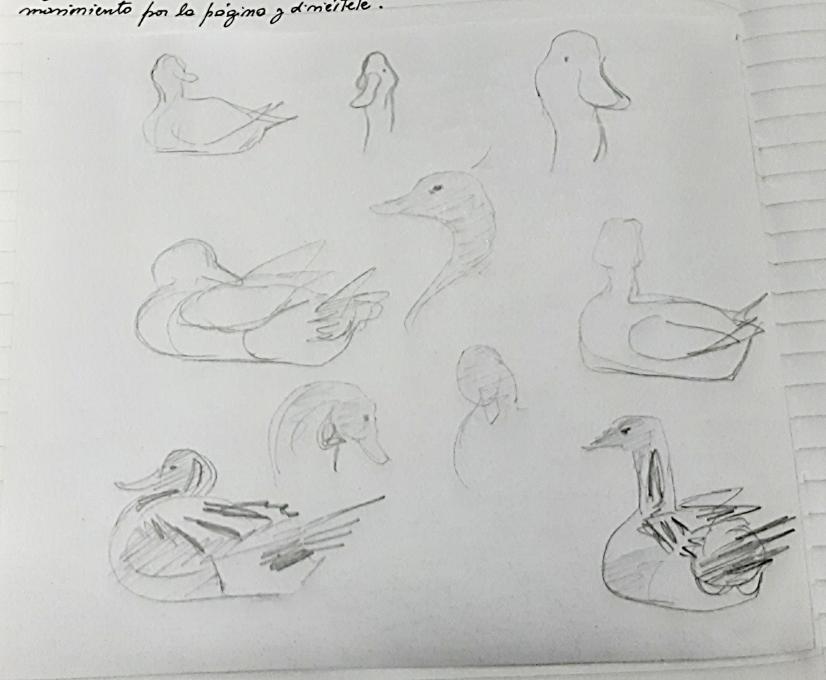

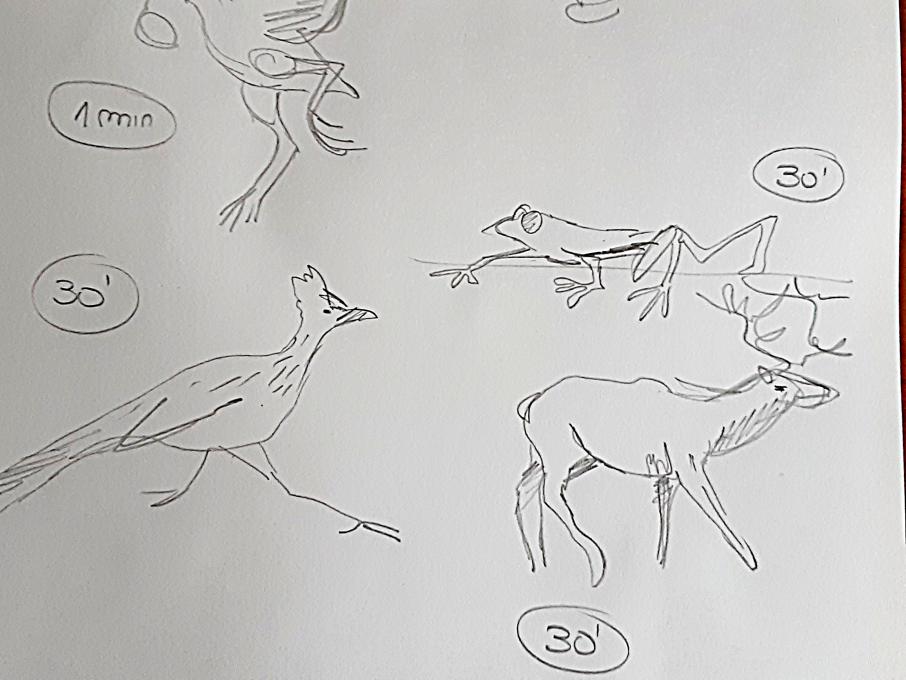
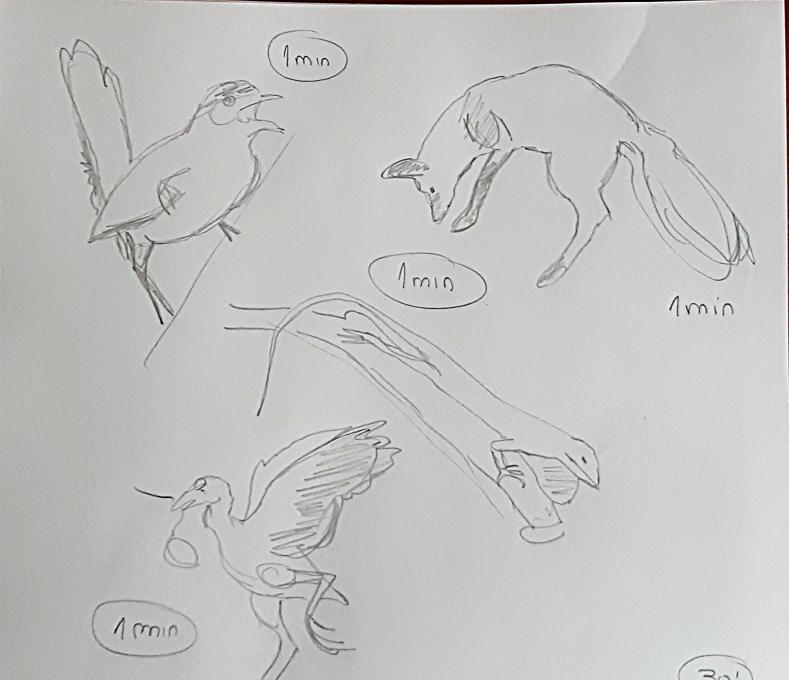

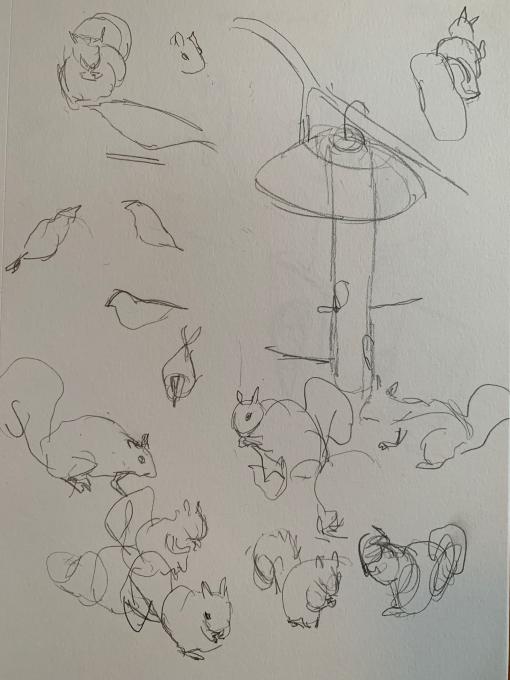
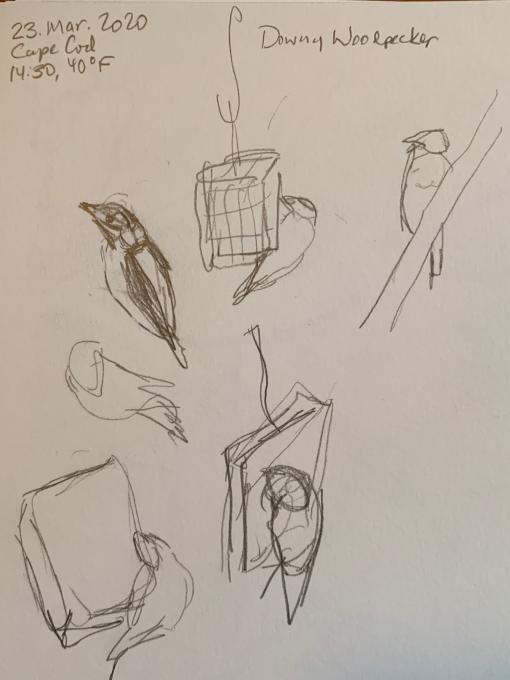
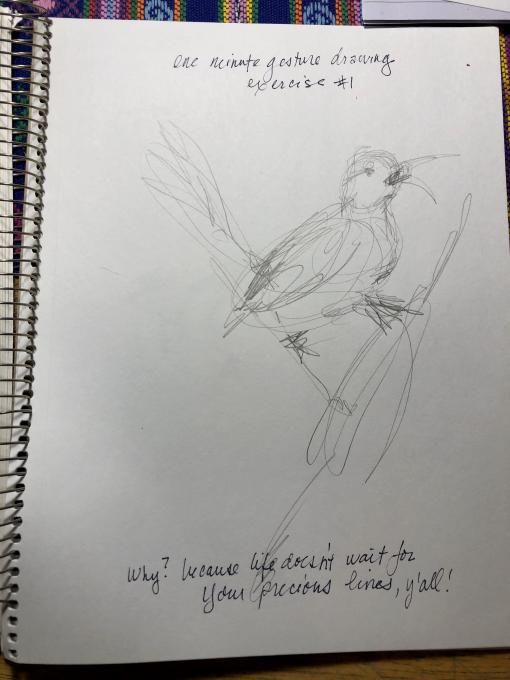

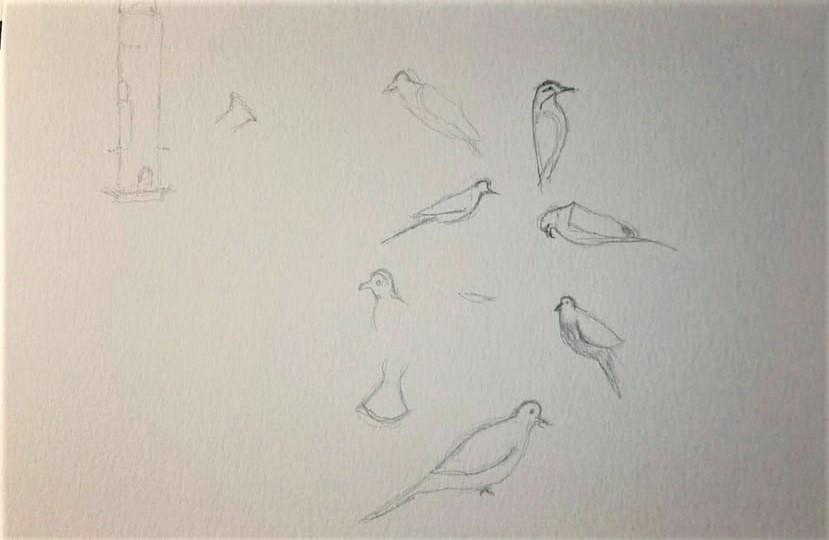
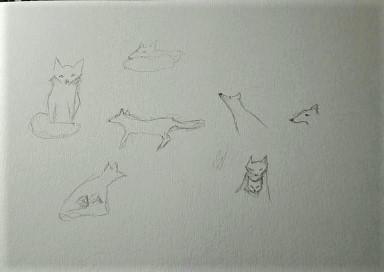
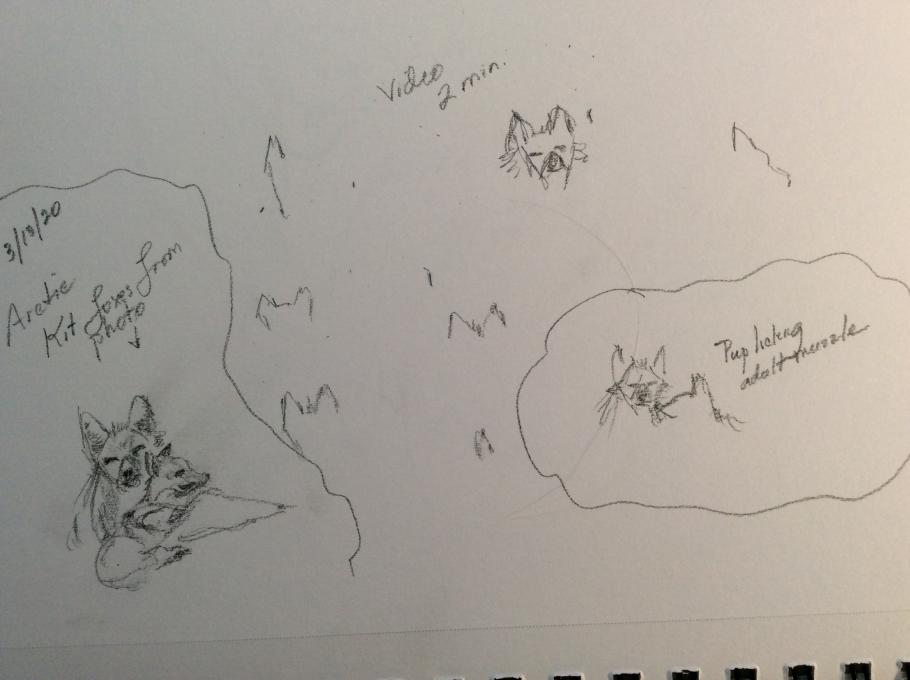
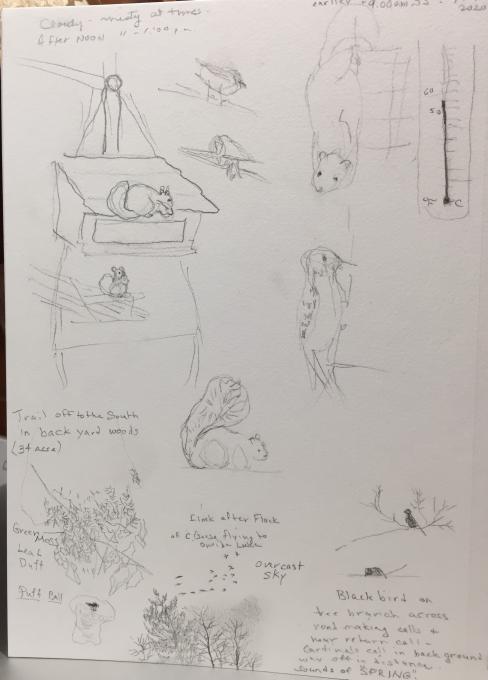
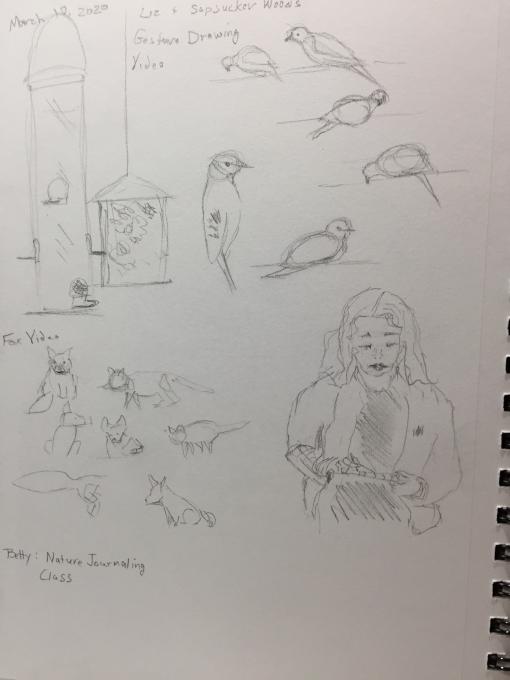 I found that with my attempts at gesture drawing I tend to try to do some refining of my sketches rather than continuing on to the next subject. I see the importance of getting the gestures down as accurately and as quickly as possible because the subjects move so quickly, such as the song birds and squirrels that frequent my yard. I've included 2 pages; the 1st page has to 2 parts, the top half shows gesture sketches from a window overlooking my bird feeders (that have been taken over by red squirrels) I've tried to capture a few gesture sketches of red squirrels, chickadees and woodpeckers, the bottom half of the page is from a walk in my woods this morning showing scenes from a tree trunk with moss and some kind of mushroom that dried out and puffs out powder when you flatten it, another scene is of geese flying overhead. The mushroom or toadstool, whatever it is, leads to a great question as to finding out just what it is and why it puffs out a brownish powder, questions that lead to other questions that need answering. The 2nd page is from the video with Liz at the bird feeders in Sapsucker Woods. The fox video was very hard to follow as the baby fox was so active. That one was really a challenge.
All in all I think gesture drawing is a great practice for every session or as a warm up. I think it is quite fun to do.
I found that with my attempts at gesture drawing I tend to try to do some refining of my sketches rather than continuing on to the next subject. I see the importance of getting the gestures down as accurately and as quickly as possible because the subjects move so quickly, such as the song birds and squirrels that frequent my yard. I've included 2 pages; the 1st page has to 2 parts, the top half shows gesture sketches from a window overlooking my bird feeders (that have been taken over by red squirrels) I've tried to capture a few gesture sketches of red squirrels, chickadees and woodpeckers, the bottom half of the page is from a walk in my woods this morning showing scenes from a tree trunk with moss and some kind of mushroom that dried out and puffs out powder when you flatten it, another scene is of geese flying overhead. The mushroom or toadstool, whatever it is, leads to a great question as to finding out just what it is and why it puffs out a brownish powder, questions that lead to other questions that need answering. The 2nd page is from the video with Liz at the bird feeders in Sapsucker Woods. The fox video was very hard to follow as the baby fox was so active. That one was really a challenge.
All in all I think gesture drawing is a great practice for every session or as a warm up. I think it is quite fun to do. 
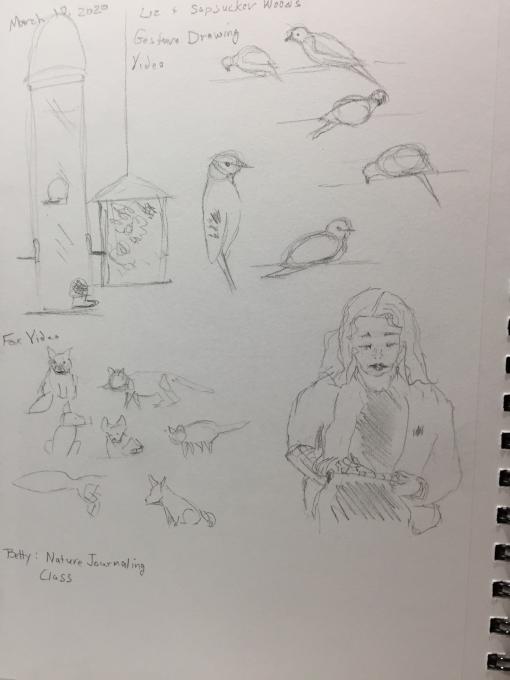
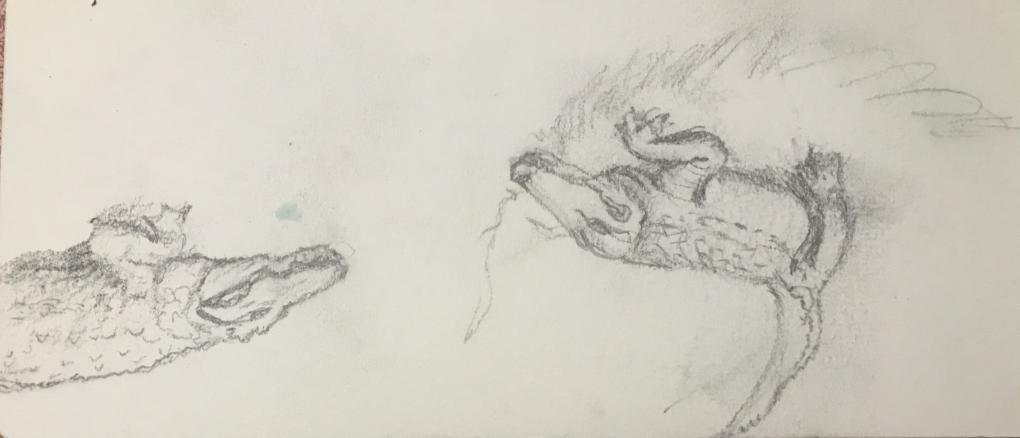
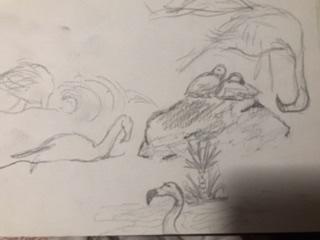
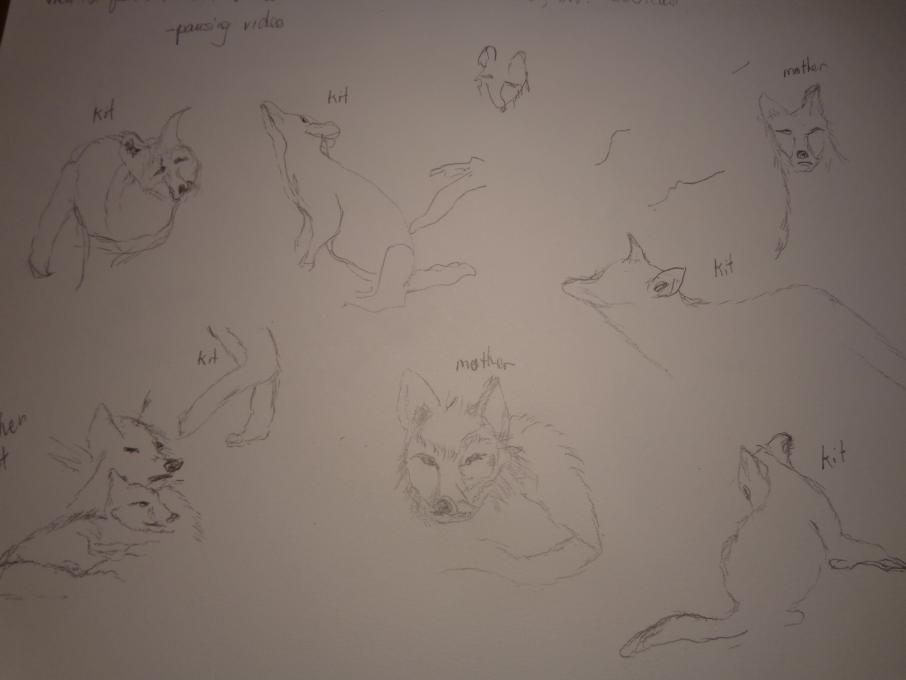

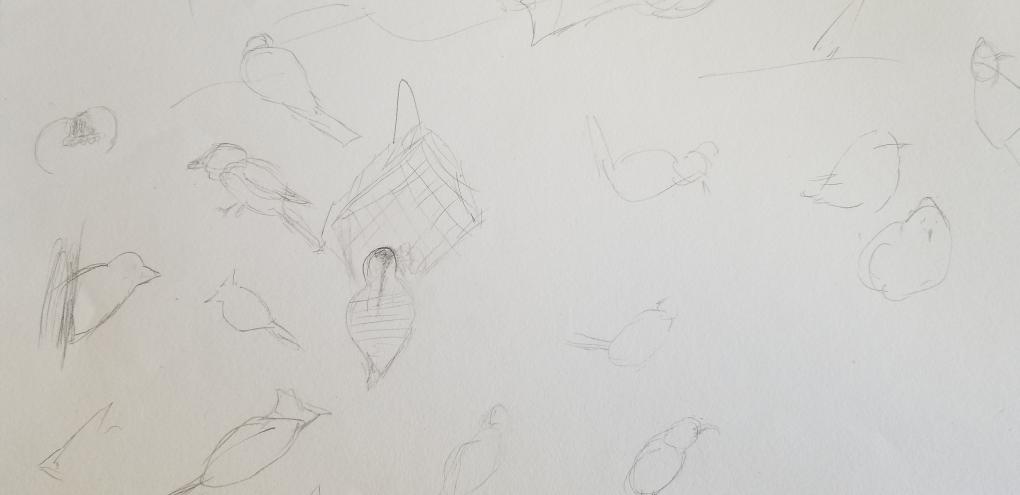
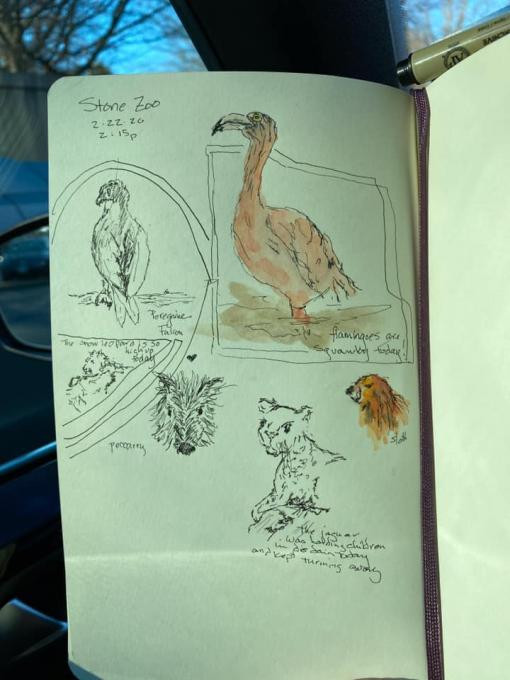 I was at the zoo the other day.
I was at the zoo the other day. 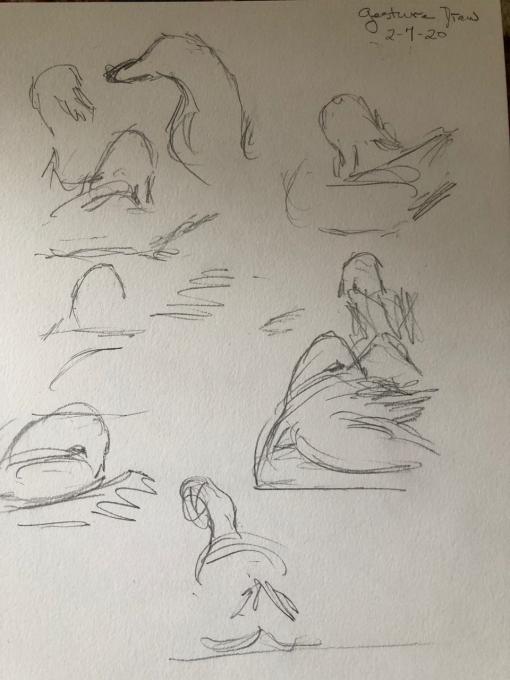
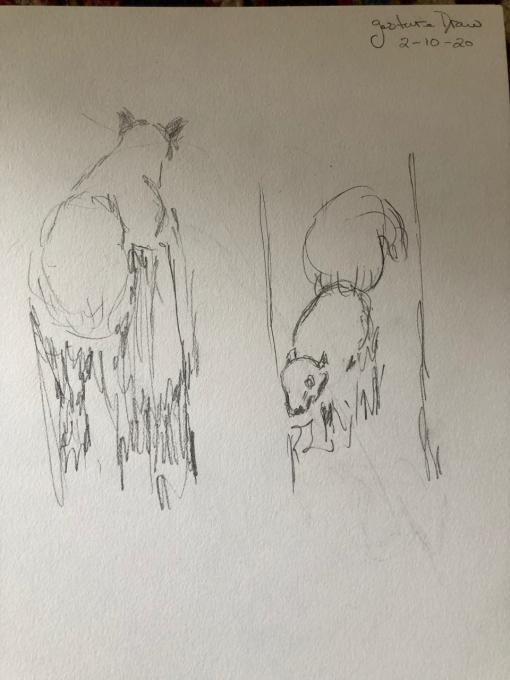
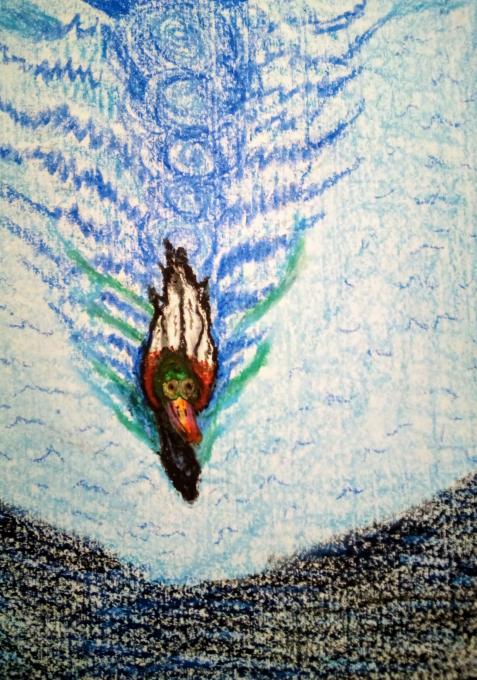 This is a sketch, with oil pastel/crayon type colorings. A duck, creating ripples,paddling on the way to the shore. A Movement. A mix of realism and impression/expression.
This is a sketch, with oil pastel/crayon type colorings. A duck, creating ripples,paddling on the way to the shore. A Movement. A mix of realism and impression/expression.  I was better with the longer sketch. I need time to space and measure. Next up is a duck, crossing a river, towards me. As my movement sketch. Getting better, each try.
I was better with the longer sketch. I need time to space and measure. Next up is a duck, crossing a river, towards me. As my movement sketch. Getting better, each try. 
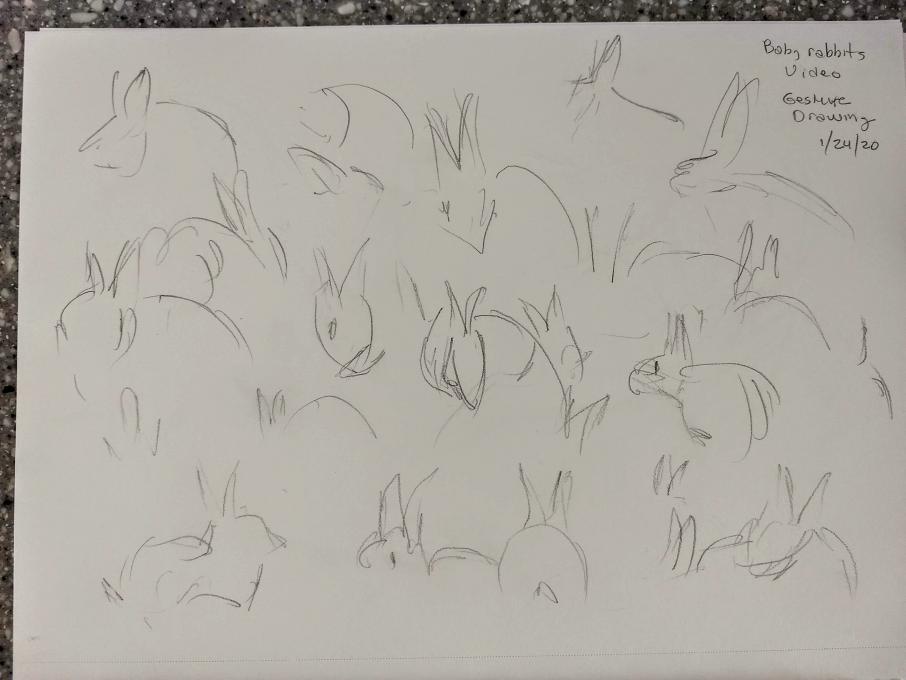
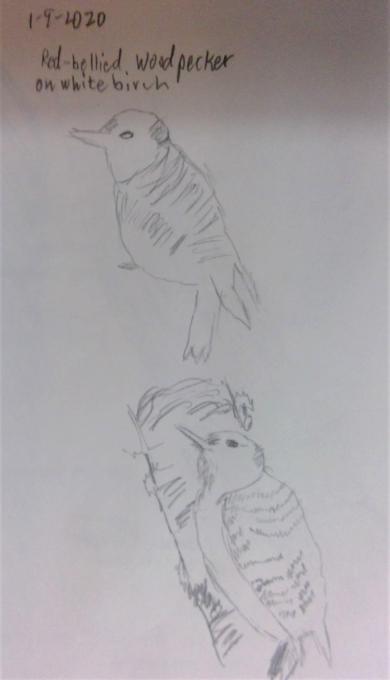
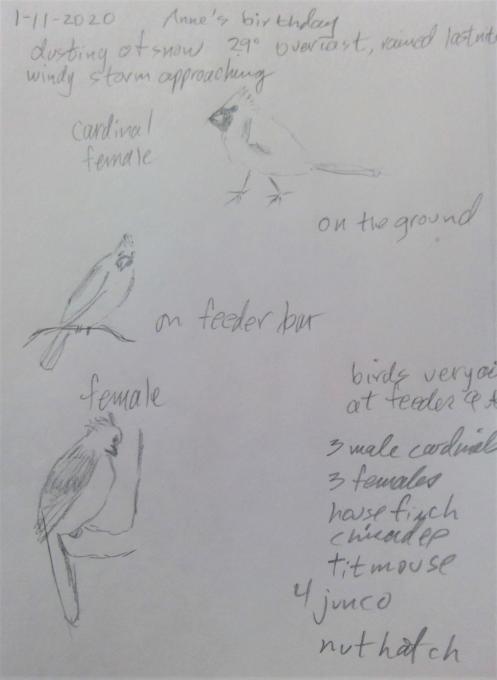
 I struggled and continued but I see progress as I noticed shape and position, turning the head. It is worth it. I am finding details I didn't look for when listing and observing without sketching.
I struggled and continued but I see progress as I noticed shape and position, turning the head. It is worth it. I am finding details I didn't look for when listing and observing without sketching.